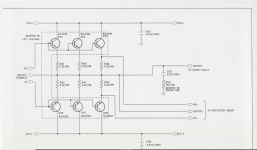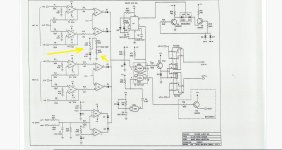Hello every one
I have a Classe ca 150 with some burned output transistors and also have some new MJL transistors laying around. is it just to swap out the 2SC4029 and 2SA1553 to MJL21194G and MJL21193G ??
the service manual is attached
I have a Classe ca 150 with some burned output transistors and also have some new MJL transistors laying around. is it just to swap out the 2SC4029 and 2SA1553 to MJL21194G and MJL21193G ??
the service manual is attached
Attachments
2SC/2SA are considerably faster (ft > 30 MHz nominal ) output transistors than the MJLs (ft = 4 MHz) , look at the ft vs Ic diagrams.
Their hfe is about 50% higher and COB half of the MJLs.
Id say it makes a pretty poor replacement.
I say 2SA1943/2SC5200 are a better replacement. If they fit physically, I have not checked pinout and package sizes (I think one is TO-284 and the other TOP3L) If you dont go abroad, for sorucing:
https://www.electrokit.com/en/2sa1943-to-264-pnp-230v-15a
https://www.electrokit.com/en/2sc5200-to-264-npn-230v-15a
Or
https://lukaseparts.se/product-category/diy-komponenter/transistorer/bipolara-bjt/effekttransistorer
Th
Their hfe is about 50% higher and COB half of the MJLs.
Id say it makes a pretty poor replacement.
I say 2SA1943/2SC5200 are a better replacement. If they fit physically, I have not checked pinout and package sizes (I think one is TO-284 and the other TOP3L) If you dont go abroad, for sorucing:
https://www.electrokit.com/en/2sa1943-to-264-pnp-230v-15a
https://www.electrokit.com/en/2sc5200-to-264-npn-230v-15a
Or
https://lukaseparts.se/product-category/diy-komponenter/transistorer/bipolara-bjt/effekttransistorer
Th
yep that is all correct. thishibao ahve a very good ft and less Cob then others.
if you need more power then 15oW 2SC5200 you can use the big brothers --> 2SC5359_O -180W
kr
chris
if you need more power then 15oW 2SC5200 you can use the big brothers --> 2SC5359_O -180W
kr
chris
The service manual shows the amp originally having MJL21193/4. Yours came with C4029/A1553?
Those Toshiba parts are faster, but not as high as devices like the C5200. With 3 output pairs on those voltages I’d be going for the most rugged devices available, not pushing the fT. Drivers are hefty mosfets, which will have no problem pushing charge in and out of the output transistor bases. I’d be more inclined to go back to the MJL21194 specified, or the MJL3281 as the higher speed alternative.
Those Toshiba parts are faster, but not as high as devices like the C5200. With 3 output pairs on those voltages I’d be going for the most rugged devices available, not pushing the fT. Drivers are hefty mosfets, which will have no problem pushing charge in and out of the output transistor bases. I’d be more inclined to go back to the MJL21194 specified, or the MJL3281 as the higher speed alternative.
Aha...i understand . then it is clear for me to keep the OPS transitor "slow" but deliver at 120V or bigger the better current availability at higher current.
as i read in a other thread the thosibas cannot keep the higher current as good as the MJL-parts

thosiba

thx
chris
as i read in a other thread the thosibas cannot keep the higher current as good as the MJL-parts
thosiba
thx
chris
Last edited:
wg ski, I didnt check the manual
That changes the game considera ly.
If it orignially was designed for the 21193/94 I would absolutely not switch to faster Toshibas or any brand with almost a magnitude higher Ft , atleast not without more evaluation about stability etc.
21193/4 also are very rugged.
That changes the game considera ly.
If it orignially was designed for the 21193/94 I would absolutely not switch to faster Toshibas or any brand with almost a magnitude higher Ft , atleast not without more evaluation about stability etc.
21193/4 also are very rugged.
oh...yes - you are right. so its not really comparable.
sorry
is there anywhere a better comparision?
sorry
is there anywhere a better comparision?
Last edited:
Because they are the highest power Toshiba parts that were available at the time. Using alternate types is not unheard of. Their manufacturing documents probably specify that either can be used, as long as they stay in their respective pairs (ie, “do not mix”).
With those answers and that fackt and considering all the components are same in this amp as in the manual. resistors,caps etc have the same value.
It's seams like there will not be anny complications to go for 21193/94.
I Don't know how it sounded with C4029/A1553.
So what different 21193/94 will give to the sound is better to leave un solved I guess?
It's seams like there will not be anny complications to go for 21193/94.
I Don't know how it sounded with C4029/A1553.
So what different 21193/94 will give to the sound is better to leave un solved I guess?
Any difference in sound between the two are most likely imagined. The amount of crossover distortion produced depends on two things (other than optimum bias current): Output transistor fT and the driving point impedance at the base(s). It is more dependent on the latter than the former. That’s why the big mosfets were used - to run them at a high enough bias to overcome their own distortion, and provide a low enough impedance to suck out any reasonable amount of base-emitter charge, quickly. You might not be able to turn those old 200-800kHz RCA hometaxials off fast enough, but you wouldn’t even have PNPs either. And you would be hand selecting them just to handle the voltages and to get ANY sort of a match between devices. MJL21194s are WAY better than that.
In a standard “Blameless” with an EF2 bipolar output stage, 30+ MHz outputs are mandatory. Here they are not. Will it hurt? Sound wise no - but if you trade too much ruggedness for fT they won’t hold up.
In a standard “Blameless” with an EF2 bipolar output stage, 30+ MHz outputs are mandatory. Here they are not. Will it hurt? Sound wise no - but if you trade too much ruggedness for fT they won’t hold up.
- Home
- Amplifiers
- Solid State
- Classe CA 150 swap output transistors to MJL21194G from 2SC4029

